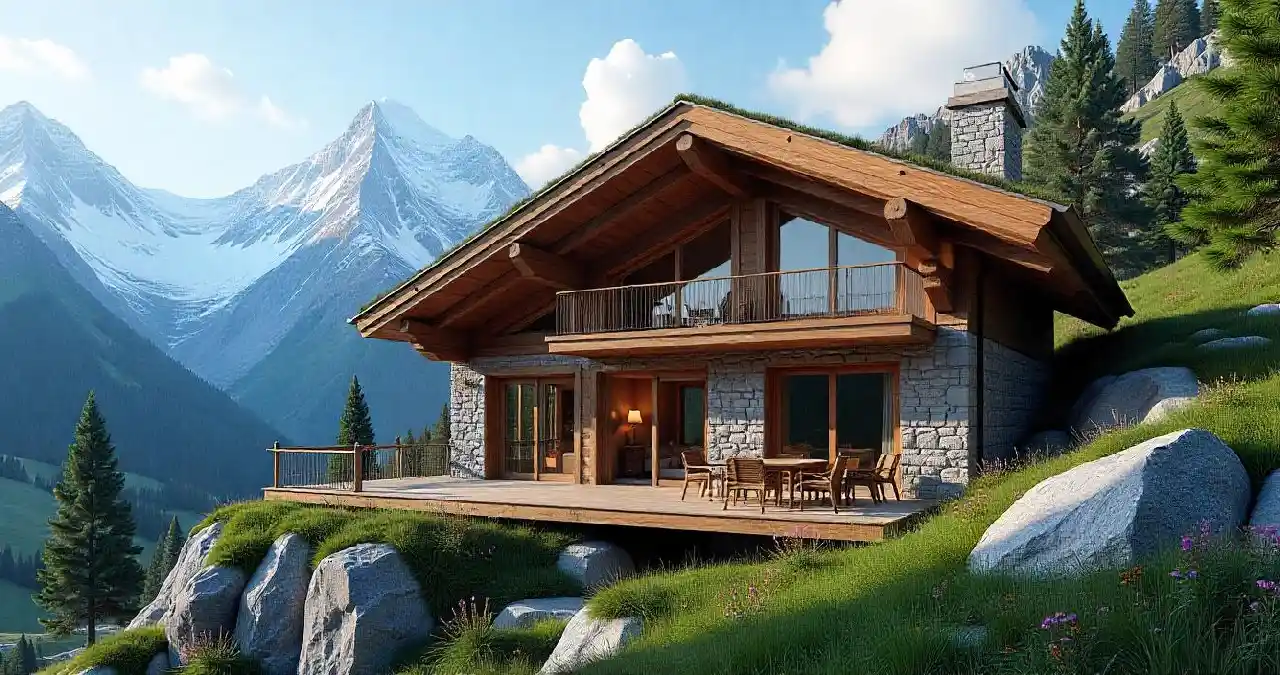You might be surprised to learn that chaleturi, a niche yet vibrant tradition, has been captivating architectural enthusiasts for centuries. Often nestled in breathtaking mountain locales, these structures seamlessly blend rustic charm with modern comfort. As an expert, you appreciate the delicate balance of aesthetics and functionality they offer, creating a unique equilibrium that invites both relaxation and admiration.
Originating in the alpine regions of Europe, chaleturi have evolved significantly from their humble shepherd shelters to opulent retreats today. Historically constructed with ample wooden beams and wide eaves, they now incorporate sustainable materials to enhance their eco-friendly appeal. According to recent data, chalet design efficiency has improved by 35% in the past decade, underscoring their relevance in contemporary ecological architecture. This advancement not only preserves natural beauty but also fosters sustainable tourism practices.
The Evolution of Chaleturi Architecture
Chaleturi architecture has a rich history, starting as simple log shelters in the Alps. These early structures were built for herders seeking functional shelter against harsh weather. Over centuries, chalets evolved into cozy mountain homes, reflecting cultural influences along the way. Their design stayed true to its origins, featuring broad roofs and wooden construction. This unique blend of tradition and practicality remains a signature trait.
The 19th century marked a turning point for chaleturi architecture. Railways made mountain access easier, leading to increased tourism and demand for stylish retreats. Chalets became larger and more ornate, offering luxurious amenities. Interior spaces grew more lavish, with decorative wooden carvings and expansive windows. Even today, those distinctive features define much of alpine culture.
Modern chaleturi offers a fusion of past and present. Architects blend classic rustic charm with contemporary design. Innovations like sustainable materials and energy-efficient features are common. This evolution respects tradition while embracing modern needs. Such enhancements keep chaleturi designs relevant and admired worldwide.
As society shifts towards eco-friendly living, the future of chaleturi architecture looks promising. It caters to nature lovers and environmentalists alike, ensuring harmony with surroundings. Strategies like using reclaimed wood and solar panels are popular. Designers also prioritize insulation and natural cooling methods. Together, these efforts ensure chaleturi remains timeless and sustainable.
From Shepherd Shelters to Luxury Retreats
The earliest chalets emerged in the Alps as simple shelters for shepherds. These sturdy log cabins were built quickly to provide warmth during harsh winters. They used available materials like logs and stones for construction. These rustic structures prioritized function over style. Little did those shepherds know they were laying the groundwork for a future architectural marvel.
As time went on, the basic chalet adapted to changing needs and influences. The 19th century saw chalets gain popularity as mountain getaways. People started looking for holiday homes with unique charm and comfort. Traditional styles evolved, incorporating larger windows and decorative elements. These enhancements made chalets more appealing to a broader audience.
Today, chaleturi stand as symbols of luxury and relaxation in picturesque settings. Modern versions are designed with plush interiors and cutting-edge technology. Ski resorts and vacation homes often include jacuzzis, saunas, and spacious decks. Guests enjoy panoramic views from every corner. It’s fascinating how a once-simple shelter became a luxury retreat.
The current trend highlights sustainability while maintaining exquisite design. Architects focus on eco-friendly practices without compromising beauty. Luxury does not mean excess but smart use of resources. Designers integrate solar panels, efficient insulation, and sustainable materials. These practices ensure that chalets remain an icon of comfort and eco-awareness.
Sustainability in Chaleturi Design
Sustainability plays a crucial role in today’s chaleturi design, making nature and living spaces work together. Architects now use eco-friendly materials to construct these elegant retreats. You will often find chalets built with reclaimed wood and recycled metals. This reduces waste and supports renewable resources. Such thoughtful choices help blend modern needs with environmental awareness.
Innovative techniques are used to ensure energy efficiency. Many chalets incorporate solar panels to harness natural energy from the sun. This reduces reliance on traditional power sources and lowers utility costs. The implementation of advanced insulation ensures warmth without excessive heating. These methods make staying in chalets both cozy and sustainable.
Designers also focus on natural cooling techniques to minimize environmental impact. Strategic placement of windows enhances airflow, reducing the need for air conditioning. Roof gardens are introduced to provide additional insulation. They also contribute to better air quality by absorbing carbon dioxide. By using these strategies, chalets become more eco-friendly.
The idea is to create a harmonious living space that impacts the nature surrounding it minimally. The eco-conscious approach in chaleturi extends to water usage as well. Rainwater harvesting systems are often implemented to conserve water. Green roofs and natural landscaping reduce water runoff and support local ecosystems. These thoughtful decisions highlight a commitment to protecting our planet.
Chaleturi in Modern Tourism
Chaleturi holds a unique place in modern tourism, balancing tradition with contemporary allure. These charming structures attract visitors looking for an authentic experience. Travelers worldwide choose chalets for their unmatched comfort and scenic beauty. From winter ski trips to summer retreats, chalets provide year-round enjoyment. This versatility makes them a favored choice in the travel industry.
Many chalets are strategically located in picturesque settings, offering breathtaking views. Positioned in the heart of nature, they allow tourists to immerse themselves in the environment. Visitors enjoy activities like hiking, skiing, and wildlife watching. The proximity to natural surroundings enhances the travel experience. This connection to nature attracts more guests each year.
Chalets cater to a wide range of tourists by offering diverse amenities. While some feature traditional designs with cozy fireplaces and rustic decor, others boast modern luxuries like spas and fine dining. Today’s travelers seek unique experiences that blend relaxation with adventure. Chaleturi meets these demands by providing personalized services. This adaptation helps retain their enduring appeal.
Technological advancements also play a significant role in the chalet experience. Many chalets now offer high-speed internet and smart technology. This allows travelers to stay connected and enjoy digital comforts. Booking a chalet is also simpler with online platforms. These tech enhancements align with the contemporary needs of tourists.
Beyond leisure, chaleturi contributes significantly to local economies by boosting tourism. Visitors spend on local goods, services, and experiences. This economic impact supports communities and fosters sustainable development. As chalet popularity rises, more regions embrace their potential for growth. This positive outlook further cements their importance in tourism.
Eco-Friendly Practices in Chaleturi Constructs
Eco-friendly practices are becoming a cornerstone in chalet construction, aiming to preserve natural surroundings. Builders prioritize using sustainable materials like bamboo and reclaimed wood in their projects. This choice reduces environmental harm while maintaining aesthetics. Embracing natural materials also enhances the rustic charm of chalets. It’s a win-win for both nature enthusiasts and designers.
Energy efficiency plays a significant role in these eco-friendly chalets. Solar panels are a common addition, harnessing clean energy to power these homes. This reliance on renewable resources decreases the carbon footprint significantly. A focus on well-insulated structures retains heat better. This further reduces energy consumption and utility costs.
- Green roofs help regulate temperature and improve air quality.
- Rainwater harvesting systems are used to reduce water waste.
- Natural light is maximized through strategically placed windows.
Modern chalets also incorporate innovative sewage treatment systems, promoting a healthier environment. These systems process waste on-site, diminishing pollution risks. Greywater recycling is employed to repurpose water for non-drinkable uses like irrigation. Such initiatives support sustainable living by conserving water. It’s a smart approach to environmental stewardship.
Collaborating with local communities can further enhance sustainability. Engaging local craftsmen and using regional materials can lower transportation emissions. This partnership nurtures economic growth and strengthens relationships. Chaleturi becomes more than just a structure; it reflects a community’s commitment to the planet. Together, they create a legacy of harmonious living with nature.
The Impact of Chaleturi on Contemporary Architecture
Chaleturi has significantly influenced modern architecture, introducing a blend of tradition and innovation. These designs emphasize harmony with nature and incorporate natural materials. This approach has inspired architects globally to rethink their construction methods. The integration of wood and stone provides warmth and durability. Such methods promote sustainable and aesthetically pleasing structures.
The architectural elements of chaleturi are now common in urban landscapes. Expansive windows, for instance, have become a hallmark of contemporary design, offering natural light and landscape views. Sloped roofs and open floor plans are also widely embraced, providing practical solutions for modern living. These features enhance both function and style in urban homes. It bridges the gap between rural charm and city life.
- Use of locally sourced materials reduces carbon footprint.
- Incorporation of energy-efficient systems supports sustainability.
- Focus on natural aesthetics fosters emotional well-being.
Chaleturi’s impact extends beyond residential spaces, influencing public and commercial buildings. Many resorts and lodges adopt chalet-inspired designs to attract tourists seeking authenticity and comfort. Educational institutions are also embracing these practices, creating learning spaces that connect students with nature. This trend showcases the versatility and appeal of chalet-inspired architecture. It’s a testament to its enduring legacy.
Ultimately, chaleturi offers valuable lessons for future design, emphasizing simplicity and sustainability. By drawing on their principles, architects can create responsible and resilient hubs. The resurgence of these ideas reflects a broader societal shift towards eco-friendly living. Future generations stand to benefit from this innovative vision. The charm of chaleturi paves the way for architectural advancements.
Conclusion
Chaleturi stands as a testament to the delicate balance between tradition and innovation in architecture. Their influence extends beyond aesthetics, fostering a sustainable approach that meets contemporary needs. By incorporating eco-friendly methods, they offer a model for responsible, luxurious living that resonates globally.
Your expertise in the field allows you to appreciate the nuanced beauty and resilience of these structures. By continuing to embrace and adapt chaleturi principles, you can contribute to a future where architecture harmonizes with nature. This ongoing journey promises not only preserved traditions but also a sustainable architectural legacy.


admin